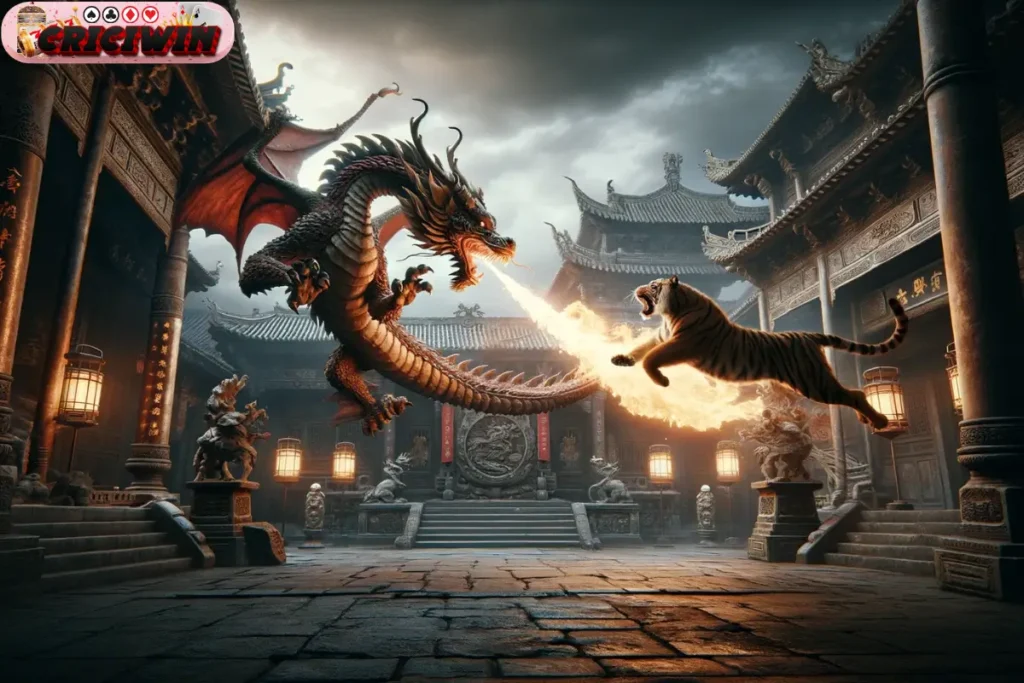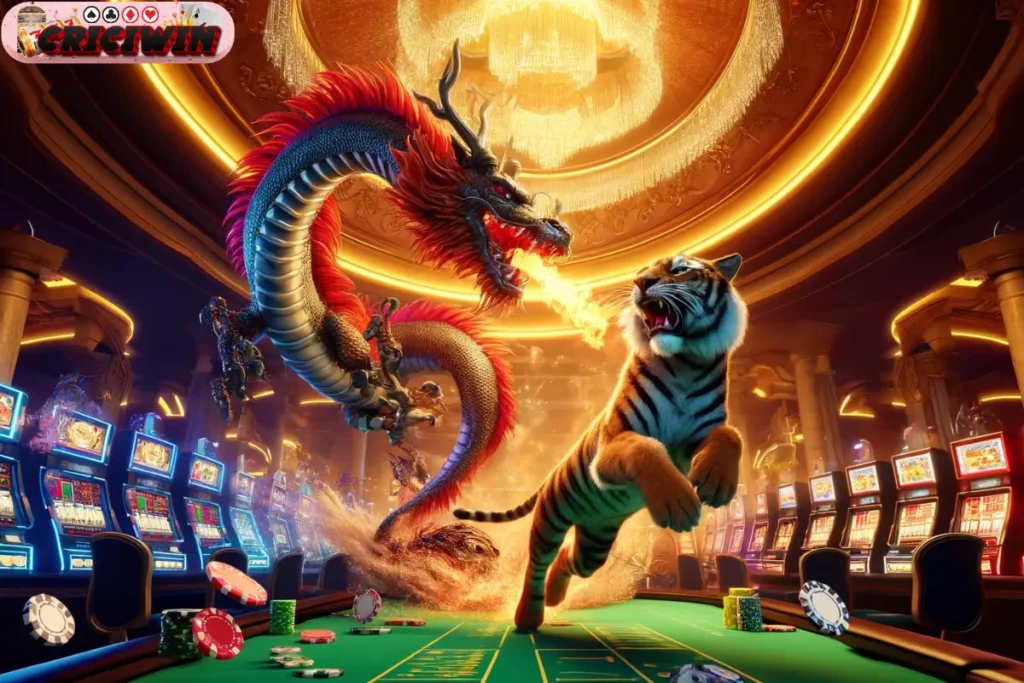Dragon vs Tiger is an electrifying casino game that pits two mythical creatures against each other in a fast-paced battle of chance. Choose between the Dragon or the Tiger, place your bets, and watch as the cards reveal the winner in this thrilling, high-stakes game. With simple rules and quick gameplay, Dragon vs Tiger offers nonstop excitement and the opportunity for big wins. Experience the adrenaline rush of this classic showdown and see if luck favors the Dragon or the Tiger!

Within the rich tapestry of mythological and cultural symbolism, there are few rivalries that are as compelling as the one that exists between the tiger and the dragon. These two magnificent animals, each of which represents great powers that are in opposition to one another, are deeply interwoven in the visual arts, mythology, and spiritual beliefs of a variety of countries, notably in East Asian nations. The tiger, which exemplifies earthly strength, courage, and ferocity, stands in stark contrast to the dragon, which is sometimes regarded as a sign of heavenly power, wisdom, and prosperity. This article investigates the origins of the enduring mythology of the dragon vs the tiger, as well as its cultural relevance and the symbolic meaning behind it. It also investigates how this duality mirrors larger issues that are present in the human experience.
Origins and Mythological Background
The Dragon
In human mythology, the dragon is considered to be one of the most ancient and most complicated emblems. Dragons, also known as Lóng (also written as 龙) in Chinese culture, are considered to be beneficent creatures that are related with water, weather, and the divine right of the emperor to govern. The dragon in Chinese culture is a symbol of good fortune and a protector against evil spirits, in contrast to its counterpart in Western culture, which is frequently portrayed as a vicious beast. As a result of the widespread belief that it possesses the ability to control rain and floods, it is an essential figure in an agricultural civilization that is dependent on the elements.
Imagery of the dragon may be dated back to the Shang Dynasty, which lasted from 1600 to 1046 BCE. During this time period, the dragon was depicted on ritual bronze containers. The portrayal of this creature has developed over the course of millennia, including characteristics from a variety of creatures, such as the body of a snake, the scales of a fish, the talons of an eagle, and the antlers of a deer. This combination highlights the fact that it is a monster that possesses enormous strength and a great deal of mystery.
The Tiger
In contrast, the tiger (虎, Hǔ) is revered as the king of all beasts in Chinese culture. It symbolizes strength, bravery, and military prowess. The tiger is often associated with the earth element and is considered a protector against the three disasters: fire, thieves, and ghosts. Its stripes are thought to form the Chinese character “王” (wáng), meaning king, further cementing its regal status.
The tiger’s significance extends beyond China, with similar reverence in Korean, Japanese, and Indian cultures. In Korea, the tiger is a guardian that wards off evil spirits. In Japan, it is a symbol of strength and martial ability. In India, the goddess Durga rides a tiger, representing her supremacy over the forces of nature and evil.
Cultural Significance and Symbolism
The dragon and the tiger are not just mythological creatures; they are embodiments of fundamental dualities in Chinese cosmology and philosophy, particularly the concept of Yin and Yang. This Taoist principle posits that the universe is governed by the interplay of two opposing forces: Yin (阴), representing darkness, femininity, and passivity, and Yang (阳), symbolizing light, masculinity, and activity.
Dragon as Yang
The dragon is typically associated with Yang. It embodies the active, masculine, and celestial aspects of the universe. Its ability to soar through the skies and control the elements reflects the expansive and creative force of Yang. The dragon’s connection to the emperor also ties it to the governance and order imposed by a powerful, authoritative figure.
Tiger as Yin
Conversely, the tiger is linked to Yin. It represents the earthly, feminine, and receptive aspects of the cosmos. Its dominion over the forest and its solitary nature mirror the introspective and nurturing qualities of Yin. Despite its ferocity, the tiger’s role as a protector highlights the nurturing and safeguarding attributes traditionally associated with femininity.
Dragon vs Tiger in Art and Literature
The dichotomy of the dragon and the tiger has inspired countless works of art, literature, and martial arts, each medium exploring the dynamic interplay between these two forces.
Visual Arts
In traditional Chinese painting and sculpture, the dragon and tiger are often depicted in combat or in symmetrical balance, illustrating the harmony of opposing forces. A famous example is the “Dragon and Tiger Pagodas” in Kaohsiung, Taiwan, where visitors enter through the dragon’s mouth and exit through the tiger’s mouth, symbolizing the journey from adversity to enlightenment.
Another iconic representation is found in martial arts temples, where murals and statues frequently depict the dragon and tiger engaged in battle. These images serve as metaphors for the internal struggle between opposing energies within a practitioner, emphasizing the need for balance and harmony.
Literature
In literature, the dragon and tiger frequently appear in classical Chinese novels and poetry, often as metaphors for the clash between heroic figures and formidable adversaries. In the famous novel “Water Margin” (水浒传, Shuǐhǔ Zhuàn), the character Wu Song is likened to a tiger for his incredible strength and bravery. Similarly, the dragon is used to describe characters of exceptional wisdom and nobility.
Poetry also abounds with references to the dragon and tiger. Tang dynasty poet Li Bai (李白) often used these animals to symbolize the grandeur and peril of nature, as well as the inner conflicts of human emotion and ambition.
Martial Arts
Perhaps the most vivid embodiment of the dragon vs tiger symbolism is found in martial arts. Styles such as Kung Fu, particularly those from the Shaolin and Wu Tang traditions, incorporate movements and techniques inspired by the dragon and tiger. The “Dragon Style” emphasizes fluid, circular movements that mimic the dragon’s agility and unpredictability. In contrast, the “Tiger Style” focuses on powerful, direct strikes and stances that reflect the tiger’s brute strength and ferocity.
These martial arts styles are not merely physical disciplines but also philosophical practices. Practitioners are taught to cultivate the qualities of both animals, achieving a balance between the softness and hardness, yielding and asserting, reflective of the broader Taoist quest for harmony.
The Dragon and Tiger in Modern Culture
The symbolism of the dragon and tiger continues to resonate in modern times, transcending cultural boundaries and finding new expressions in various fields.
Popular Media
In contemporary popular media, the dragon and tiger appear in movies, television, and video games, often as characters or motifs that evoke their traditional meanings. Films like “Crouching Tiger, Hidden Dragon” (卧虎藏龙, Wò Hǔ Cáng Lóng) highlight the blend of mystical and martial elements associated with these creatures, while also exploring themes of hidden potential and inner conflict.
Video games such as “Street Fighter” and “Tekken” feature characters with dragon and tiger motifs, drawing on their symbolic attributes to define their fighting styles and personalities. These representations help to introduce the rich cultural heritage of the dragon and tiger to a global audience.
Fashion and Design
Fashion and design industries frequently incorporate dragon and tiger imagery into their creations. Clothing lines, jewelry, and tattoos featuring these symbols are popular for their aesthetic appeal and cultural significance. These designs often fuse traditional and modern elements, reflecting a contemporary appreciation for ancient motifs.
Business and Marketing
In business and marketing, the dragon and tiger are often used to convey strength, prosperity, and competitive spirit. Companies in various industries adopt these symbols to represent their brand values and ambitions. For instance, a financial firm might use the dragon to signify wealth and wisdom, while a sports team might choose the tiger to embody courage and determination.
Final though
The legend of the dragon versus the tiger is more than just a story of mythological creatures; it is a profound exploration of fundamental dualities that shape our understanding of the world. From ancient mythology to modern pop culture, the dragon and tiger continue to captivate our imagination and inspire a deeper appreciation for the balance of opposing forces.
Their enduring presence in art, literature, martial arts, and everyday life speaks to the universal nature of their symbolism. The dragon and tiger remind us that the pursuit of harmony between opposing energies is a timeless quest, one that resonates across cultures and generations.
In the grand tapestry of human expression, the dragon and the tiger stand as powerful symbols of the eternal dance between heaven and earth, light and dark, power and grace. Their story is a testament to the enduring human desire to understand and harmonize the diverse forces that shape our existence.
The Game: Dragon vs Tiger
In addition to the deep cultural and mythological significance that they hold, the dragon and the tiger have also made their way into the world of video games. In Cambodia, the “Dragon vs Tiger” game, which is also commonly referred to as “Dragon vs Tiger,” is a popular casino card game that originates from Asia. Cambodia is notably acquiring a great deal of popularity in this regard. The simplicity of this game, its speed, and the excitement it delivers to players have earned it a well-deserved reputation. This fascinating game has a significant cultural impact, and we will investigate its rules, strategy, and other aspects.

Rules of Dragon vs Tiger
Dragon vs Tiger is a straightforward card game that can be thought of as a two-card version of Baccarat. Here’s how it’s played:
- Setup: The game is played with a standard 52-card deck, and the cards are ranked in traditional order, with aces being the lowest and kings the highest.
- Objective: The objective is to bet on which of the two positions – Dragon or Tiger – will receive the higher card. Players can also bet on a tie, where both Dragon and Tiger receive cards of the same rank.
- Betting: Players place their bets on either the Dragon, the Tiger, or the Tie. Some variations of the game may offer additional side bets.
- Dealing: The dealer deals one card face-up to the Dragon position and one card face-up to the Tiger position.
- Outcome: The position with the higher-ranking card wins. If both positions have cards of the same rank, it results in a tie.
- Payouts: Winning bets on Dragon or Tiger are paid even money (1:1), while a winning bet on a tie typically pays out at 8:1 or higher, depending on the casino’s rules.
Strategies for Playing Dragon vs Tiger
While Dragon vs Tiger is largely a game of chance, there are a few strategies and tips players can consider to enhance their experience:
- Bet on the Dragon or Tiger: Since the game has a relatively low house edge for bets on Dragon or Tiger, it’s generally wise to stick with these main bets rather than the Tie, which has a higher house edge.
- Avoid the Tie Bet: Although the payout for a Tie is attractive, the probability of a tie occurring is low, making it a less favorable bet in terms of long-term profitability.
- Card Counting: Unlike Blackjack, card counting is not very effective in Dragon vs Tiger due to the limited number of cards dealt in each round. However, keeping track of high and low cards can provide a slight edge.
- Manage Your Bankroll: As with any casino game, it’s crucial to manage your bankroll wisely. Set a budget for how much you’re willing to lose and stick to it. Don’t chase losses, and know when to walk away.
Cultural Impact and Popularity
Dragon vs Tiger’s appeal lies in its simplicity and the rapid pace of play, making it a favorite among both novice and seasoned gamblers. The game’s origins in Asia have helped it gain popularity in various casinos around the world, particularly in regions with a strong Asian influence.
Online Dragon vs Tiger
With the rise of online gambling, Dragon vs Tiger has found a new audience on digital platforms. Online casinos offer various versions of the game, often with live dealers to recreate the authentic casino experience. The online format allows players to enjoy Dragon vs Tiger from the comfort of their homes, adding to the game’s accessibility and popularity.
Conclusion
To say that the Dragon vs Tiger game is an intriguing combination of traditional history and contemporary entertainment would be an understatement. The combination of its ease of use and the thrill of action that moves at a rapid speed makes it an appealing option for a great number of people who enjoy playing casino games. Although the game is based on ancient symbolism, it takes these potent symbols into a modern setting. It provides a novel approach to the age-old competition between the dragon and the tiger, which has been going on for centuries.
It doesn’t matter if you’re driven to the game because of its cultural links or because of its basic mechanics; Dragon vs Tiger is a strong example of how traditional themes can be given a fresh start in contemporary gaming. It acts as a bridge between the past and the present, demonstrating the enduring fascination of the dragon and the tiger in the human imagination, and it continues to attract more and more people as its popularity continues to rise.




Hi, this is a comment.
To get started with moderating, editing, and deleting comments, please visit the Comments screen in the dashboard.
Commenter avatars come from Gravatar.
Pingback: Exploring Six6s: Your Ultimate Guide to Online Casino Thrills in Pakistan - Crici Win